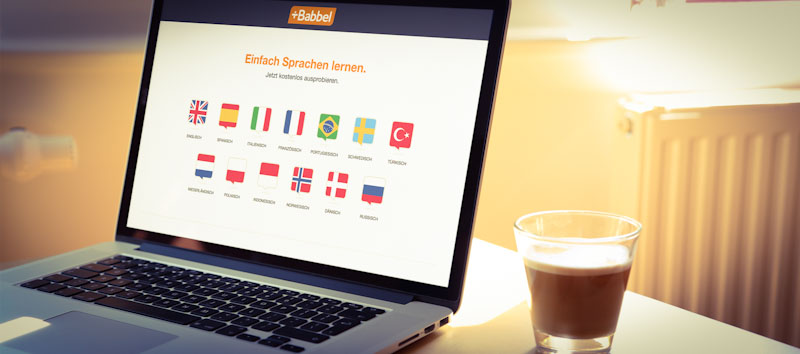Title image: © Lesson Nine GmbH
Welcome to our 6th Babbel review. Yes, we’ve been reviewing Babbel since 2012 and here we’re sharing our Babbel experiences with you. A lot has changed, especially regarding features—and not all changes have been good.
Table of Contents
Overview: Babbel in Our Review
Advantages
- Clean, easy-to-use interface
- Learning with AI
- High-quality extra content
- Diverse exercise formats
- Free trial option
Disadvantages
- Some important features removed
- Traditional learning approach
- Limited material at higher levels
- Babbel lost some of its unique charm
Quick Conclusion: Climbing Steadily with New Features
In earlier Babbel reviews, we liked calling this popular provider the “people’s language course.” It’s a program for your pocket, and it’s especially good for mobile learning. There’s a lot to like about Babbel: They frequently introduce new content and features, which are generally high in quality.
While we still don’t understand why some great and important features—like the community function or the dictionary—were scrapped, the frustration over those decisions is starting to fade. Babbel is doing one thing right: keeping up with the times. In recent months, they’ve added some really valuable new tools to their language courses, including AI-based learning, gamification, and authentic extras like podcasts. That said, from our perspective, Babbel is now just one language-learning app among many and has somehow lost its original character.
Overall, the app’s design is quite nice and it’s fun working through the varied exercises. If you sign up, you can test the first lesson in any language for free, and the 20-day money-back guarantee is fair.
In terms of pricing, Babbel has grown more expensive, but we generally find the cost justified. Especially the new lifetime offer and Babbel for Two are worth it, in our view, if you’re serious about language learning, especially compared to shorter monthly subscriptions.
But WATCH OUT! Babbel’s in-app prices are usually much higher! That’s why you should always buy via their website. You can still use the complete course on your smartphone or tablet with your login credentials, but you’ll save a lot of money!
Below is the detailed review where we also explain why we think Babbel has lost some of its charm. These Babbel experiences come from several weeks of intensive testing. If you need even more info, check out our big Babbel guide.
🡳 Babbel In-Depth Review 🡳
Online and mobile language learning—that’s what Babbel does! But how good is this online language course, really? For our review, we compiled all our latest Babbel experiences in detail. Does Babbel still have the potential to be the go-to language course for everyone in 2025?

Babbel Experiences: What Did We Test?
We put the Babbel online language course through its paces. That included using the web-based browser version as well as the mobile apps for smartphones—essentially, the course for your pocket.

‒ Black Friday: Language Special ‒
Saving money never hurt anyone, right?
Find the best discounts and exclusive coupons for top
language courses here!
+ + + Limited-Time Deals +++ Some Offers Expiring Soon +++ Don’t Miss Out! + + +
We also tried multiple languages. Spanish faced the same scrutiny as the slightly more “exotic” Russian. We also tested English, since it’s always in high demand. We took a close look at all three courses and spent several weeks gathering Babbel experiences.
Scope and Features: What Does Babbel Offer in 2025?
Babbel has expanded significantly in recent years and currently offers a good base selection of languages. Depending on the language, you’ll find more or fewer course materials, since the level you can reach varies quite a bit, as we’ll see.
Which Languages Can You Learn with Babbel?
In total, Babbel currently offers the following 14 languages to learn:
- English
- Spanish
- French
- Italian
- Portuguese
- Swedish
- German
- Turkish
- Polish
- Dutch
- Danish
- Norwegian
- Indonesian
- Russian
That covers nearly all of the most requested languages, except for Chinese (Mandarin). Generally speaking, you might wish they’d add more Asian languages, since they’re growing in popularity. And while they don’t offer many “exotic” languages, Babbel’s selection is broader than many other online courses.
Course Content and Language Levels in Our Babbel Review
Each language course is split into levels, each containing multiple short units. English and Spanish are currently the most fleshed-out. You can theoretically reach up to C1 level using the CEFR, while some other languages only go up to A2 (beginner) for now.

Beginner courses cover simple day-to-day topics like small talk, leisure time, sports, and music. The level you can reach, based on the CEFR (Common European Framework of Reference) for languages, is A2.
Intermediate courses are split into refresher and upper-tier courses. English has 2 refresher and 4 upper-tier courses. Topics get more in-depth as you head toward about B2. You’ll learn to have more detailed conversations on travel, different countries, or less common items.
Advanced courses are the next level after intermediate, letting you reach up to C1, which is nearly native-level proficiency. Currently, only English and Spanish offer advanced courses.
Additional courses cover all sorts of topics. For instance, “Business English” teaches job-related vocabulary for international exchanges, while “Land und Leute” (Culture and People) focuses on travel. Those who want to target specific skills can dive into “Grammar,” “Words and Sentences,” “Reading and Writing,” or “Listening and Speaking.” There’s also an “Extras” course with specialized topics like idioms.
Sounds pretty comprehensive, right? For English and Spanish (etc.), it definitely is. Unfortunately, not all languages get the same depth: for example, the Russian course only has a handful of beginner units so far—likely fine for a short vacation, but not enough to become fluent.
So keep in mind that while European languages can be studied quite thoroughly with Babbel, there isn’t as much material for the other languages. The most expansion in the last four years has happened in English and Spanish, whereas something like Danish or Indonesian still lags behind. We’re curious to see how Babbel’s coverage grows in the next few years!
Great Features Removed by Babbel
Babbel still offers a few extra features outside of the core lessons. One of them is a placement test you can take before you start learning. Babbel asks 12 multiple-choice questions at varying difficulty levels, then automatically places you so you don’t have to start from scratch. It works well in our Babbel experiences and is great for returning learners or those with some prior knowledge. Babbel also includes a handy built-in vocabulary trainer, which we’ll discuss soon.
Now for our biggest gripe: Babbel has completely removed three once-awesome features. They used to have a points system that awarded a certain number of points for correct answers. It wasn’t just about gamification; it was also motivating because you could compare your score with other learners. Today, it’s gone, so the learning process now feels more textbook-like, lacking that playful element.

‒ The Best Language Course of 2025 ‒
We’ve tested dozens of language courses…
But only ONE takes the #1 spot!
While you used to be able to add your own vocabulary to Babbel’s trainer, that option is also gone. Now you’re stuck learning on Babbel’s pre-set “syllabus.” That’s a shame and once again feels more like school than flexible, self-directed learning. Plus, the dictionary is no longer available.
Lastly, a strong feature in older versions was Babbel’s active international community. You could connect with other learners and native speakers to find conversation buddies, pen pals, or people to correct your writing. This is now completely gone: you can’t interact with other learners and are essentially left on your own. That’s a huge loss, as few language platforms offer a built-in community. Babbel used to stand out for this, but we have to deduct points for removing it. If you need a robust community, check out Busuu, which integrates its community seamlessly, or the self-study platform LingQ, with extensive options for connecting with other learners and native speakers.
What’s New at Babbel: Replacements for the Old Features?
Babbel has introduced a few new features recently: online lessons via Babbel Live, two types of AI-based exercises, plus some mini learning games and extra content in the “Discover” menu. Most of these aren’t integrated directly into the main language-learning path; you access them separately under “Discover.”
The learning games are short mini-games, each just a few minutes, where you review the vocabulary and phrases you’ve already learned in different formats. The main goal is still learning, but it’s clear these gamification elements are attempts to replace the removed features—and they don’t fully make up for it. A decent dictionary would have been more helpful.
There’s also extra content like podcast formats and a blog called “Babbel Magazine,” letting you browse various themes and skill levels. It’s a neat feature!
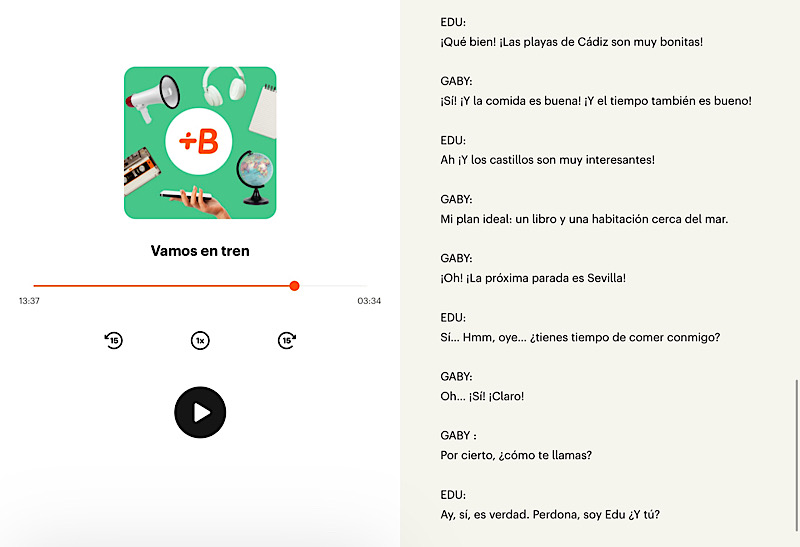
One of the best additions is the “Listening Practice” section, which has guided dialogues in the target language presented in a well-structured way. You’ll hear multiple native speakers, can follow along with transcripts, and get plenty of grammar info. There’s even a little quiz at the end—excellent! Unfortunately, there aren’t that many episodes yet, but we’re looking forward to more.
The newest tab, “Everyday Conversations,” lets you pick from a variety of short scenarios you might encounter in daily life. The practice has two phases: first, you hear a quick dialogue, then you speak it yourself. An AI rates your pronunciation, which works well. There’s no detailed feedback, just a traffic-light system for how close your pronunciation is. While that’s a bit basic, it’s a solid addition—especially since Babbel’s main program rarely requires you to speak out loud.
Babbel Live: Are We Impressed by Their Online Lessons?
Babbel Live lets you join small-group virtual lessons. You’ll find a mix of topics and certified teachers. At the moment, Babbel Live costs extra and isn’t included with the main course. We tested this feature extensively, and you can read our dedicated post about it here!
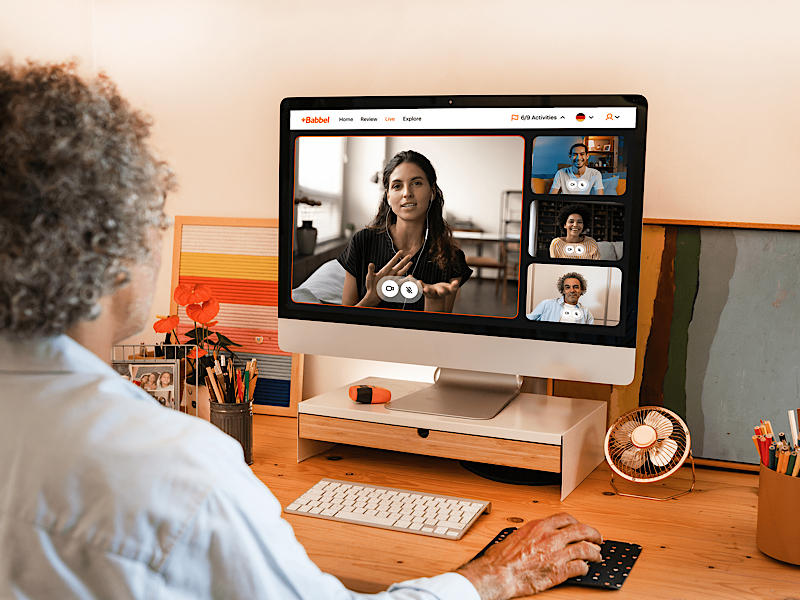
In short, Babbel Live didn’t initially impress us, but thanks to multiple updates and improvements, it’s now fairly competitive. With small-group lessons, you spend a lot of time listening to other people’s mistakes, and the class topics don’t tie in directly with your main Babbel course.
On the upside, since Babbel Live’s launch in 2021, the language options have expanded, and private lessons are now available. Prices have also been adjusted to be more fair in our view, particularly since each Babbel Live subscription also unlocks all Babbel course content. Plus, if you already have a Babbel subscription, you get a few free Babbel Live trial lessons of your choice. It can’t hurt to try!
User-Friendliness: How Easy Is Babbel to Use?
User-friendliness definitely affects your learning experience—if it’s poorly done, it leads to frustration. How good is Babbel’s setup, and how do the app and web versions differ? Here are our direct Babbel experiences from a user’s perspective.
Babbel Is Straightforward and Very Accessible
The program is extremely easy to use, and even non-tech-savvy learners can navigate it smoothly. The interface is very clean, and the lesson content is diverse and up-to-date. Babbel also handles all of your learning organization, while preserving some level of personalization: each week, you can set a learning goal, and Babbel adjusts your activities accordingly.
We especially like that the structure is improved and the pricing/plan details are now displayed more transparently, plus there’s a free 7-day trial (we’ll get to that!). This used to be a big criticism for us, so it’s nice to see it addressed. However, it’s worth noting that Babbel no longer offers 1-month subscriptions or multi-language packages. It’s unfortunate they removed these options, which many learners might have found useful.
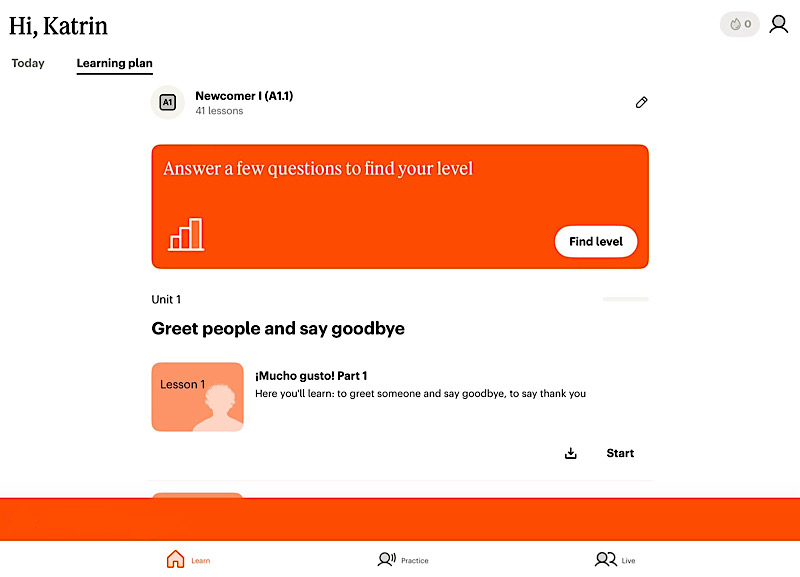
The built-in vocab trainer also works quite smoothly. Any new words from your lessons automatically sync to Babbel’s review manager, so there’s no extra step for you. The program also automatically reminds you when it’s time for a refresher.
App vs. Web: My Babbel Experiences
You can use Babbel on almost any device—computer, tablet, or smartphone—and your progress stays in sync. You can switch between devices without missing lessons or duplicating anything. You can even download content on your phone or tablet for offline use, which is handy if you’re traveling abroad without constant Wi-Fi.
The desktop and mobile versions have all the same core features. This is a major plus, since many other services don’t. The interface layout does vary a bit: the browser version is simpler to navigate. For instance, you’ll see a “Prices” tab right away on the website, while in the app you have to dig through “Profile” and “Settings” to finally get to the not-so-obvious “Unlock” tab to view plan details.

‒ The Best Language Course of 2025 ‒
We’ve tested dozens of language courses…
But only ONE takes the #1 spot!
So Babbel generally works fine on all devices, with all features intact, but if you want a more intuitive layout, the browser version is best. Once you figure out the app’s interface, though, you should be good to go.
Didactic Concept: How Successful Is Learning with Babbel?
The teaching method is arguably the most crucial aspect for real progress. Every provider’s approach is different. So what’s Babbel’s method, and how well does it work?
Small Bites, Big Results
Depending on your signup route, once you’ve registered, you start learning right away. Typically, you’ll see new words, phrases, or sentences, hear them spoken, and match them with images. Depending on the language and the lesson, you may have to type certain words or phrases, or you might get a short dialogue at the end. Overall, Babbel’s design is quite varied.
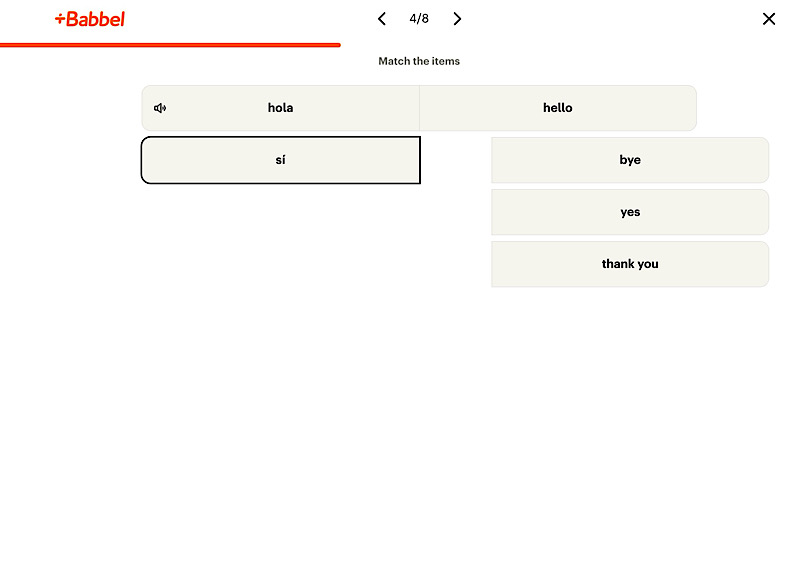
Each lesson doesn’t introduce too many new words at once (sometimes just three), but you’ll go through multiple exercises with them, giving these phrases the attention they need. The lessons are short—ideal for mobile learning and kinesthetic learners. If you want more, you can always do two or three lessons in a row.
Babbel does a decent job linking words to pictures, though they often use stock images that aren’t always super specific. Rosetta Stone (see our review) does this more carefully with their Dynamic Immersion approach.
Babbel’s Built-In Vocab Trainer: The Review Manager
Under the “Vocabulary” tab, you’ll see daily words and phrases that need reviewing. It’s best to keep up with them regularly, as they can pile up fast. If you invest a few minutes each day, you’ll stay on top of it.
Babbel employs the well-known SRS (spaced repetition system) for reviewing. Essentially, words come up at intervals: the better you know them, the more spaced-out they become. If you miss something, the spacing shrinks again.
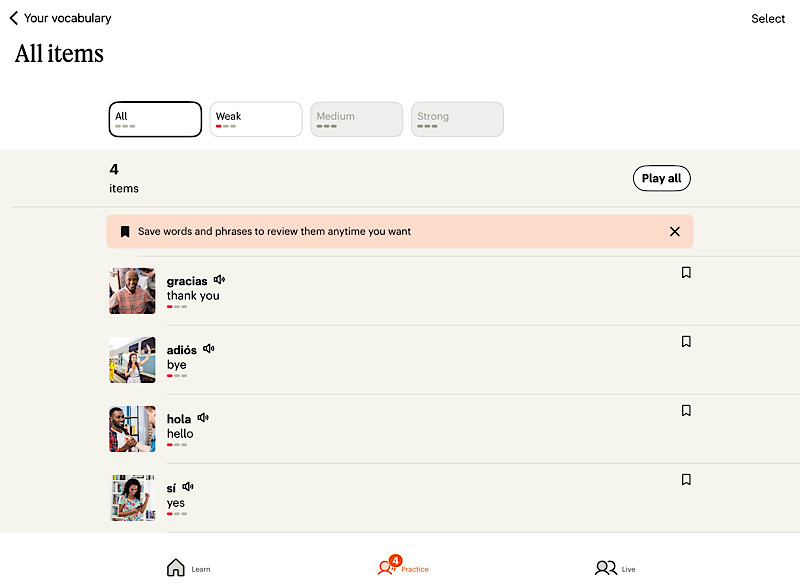
You can pick whether you learn the words with flashcards, audio-only, or by typing. They all function well. One small note: in Spanish, for instance, you can skip accent marks and still pass the exercise. That means you might end up ignoring proper spelling. This is obviously not ideal for anyone wanting to master the correct forms.
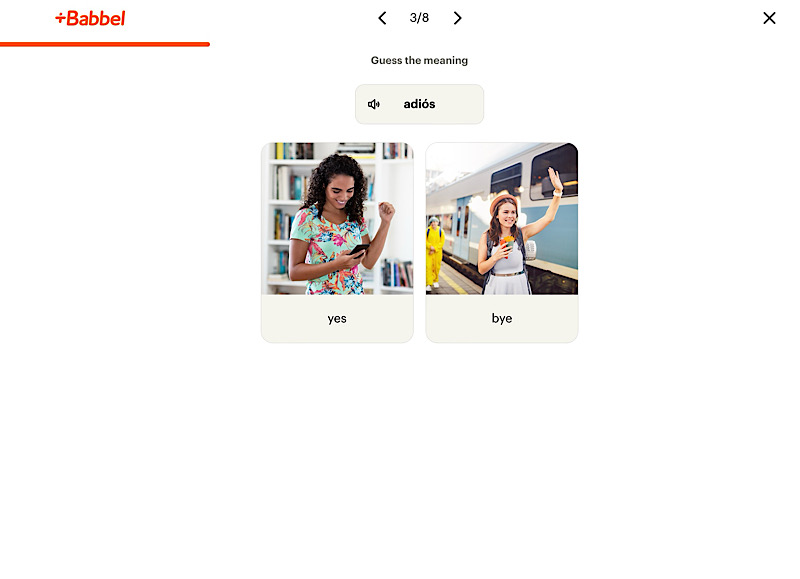
If you open the “Vocabulary” tab, you’ll see a table of all words you’ve learned so far, with translations in both your native and target languages, plus the option to hear them. You’ll also see how many times you’ve reviewed that word, the last review date, and your skill level for it. That skill level changes as you keep reviewing. If you often get it right, it goes up—make mistakes, and it can drop. There are six levels in total.
One quirk: the “number of reviews” column seems bugged. No matter how often we reviewed a word, it always said “1,” even when the skill level changed (see image). It doesn’t affect your learning, but Babbel should fix it.
Classic Didactics—Proven or Outdated?
The title says it all: Babbel frequently reminds us of traditional school-style learning, albeit enhanced by online capabilities. From an optimal learning-method perspective, we don’t think everything they do is perfect. Overall, Babbel is quite traditional.
Grammar and vocab take center stage. Programs like Rosetta Stone (review here) do this differently with their “Dynamic Immersion” approach, avoiding rote memorization. And in our transREAL method, for example, we show you how to basically load the new language directly into your brain—no mindless drilling.
Another downside is the relative lack of advanced content. If you want to learn English, you’re in luck—Babbel goes up to C1. But for Russian or Swedish, not so much. A further criticism is the minimal audio content; there aren’t many lengthy dialogs or texts. So from our experience, Babbel works better as an add-on to other methods, or for basic to intermediate skill-building. For more extensive listening, Jicki is an excellent choice.

‒ Black Friday: Language Special ‒
Saving money never hurt anyone, right?
Find the best discounts and exclusive coupons for top
language courses here!
+ + + Limited-Time Deals +++ Some Offers Expiring Soon +++ Don’t Miss Out! + + +
All that said, for beginner and intermediate levels, Babbel’s lessons are not overloaded with detail. They offer a broad overview—enough for most learners. You’ll find it’s easy to get started or to supplement what you already know.
Mid-Review: Impressions of Babbel’s Teaching Approach
From our perspective, Babbel does a lot well. It appeals to each learning style, the chunked portions of new material are sensible, and the vocab trainer is also handy. But as we noted, many outstanding features have disappeared, which impacts our rating.
While some new additions do exist, the overall teaching approach and—by extension—the learner, might have suffered a bit. Babbel is a fine gateway into a foreign language or a tool for practicing vocabulary, but it won’t dig very deep over the long term.
Who Is Babbel For? Who Benefits from This Language Course?
Who is Babbel designed for? That’s an interesting question, because Babbel manages to appeal to a pretty wide range of learners—covering different proficiency levels and learning styles.
Beginner or More Advanced?
Like many online programs, Babbel primarily targets beginners and those returning to a language after a break. Advanced learners can still use Babbel, but the approach is different.

‒ Black Friday: Language Special ‒
Saving money never hurt anyone, right?
Find the best discounts and exclusive coupons for top
language courses here!
+ + + Limited-Time Deals +++ Some Offers Expiring Soon +++ Don’t Miss Out! + + +
If you already have solid basics, focus on the specialized courses like “Business (Language)” or “Phrases” or “Idioms.” Babbel also asks if you’re brand-new or have some knowledge, and you can optionally take a placement test that puts you in the right course right away.
Everyone Gets Something… But Not Everything
We find it surprisingly difficult to assign Babbel to one of the four main learning types. There’s something for all. Visual learners have pictures. Audio types get spoken words and phrases, plus a speech-recognition tool. Those who like reading and writing can type out words, and kinesthetic learners benefit from the quick-fire tasks that don’t keep them at a desk for too long.
But with all this variety comes the sense that it’s all somewhat “lightweight.” They do a bit of everything, but rarely go in-depth. We’ve seen more specialized programs (such as pure video or audio courses, or the ones on our Top 10 language course list) that sometimes do certain aspects better.

‒ The Best Language Course of 2025 ‒
We’ve tested dozens of language courses…
But only ONE takes the #1 spot!
Here’s an example: audio practice feels lacking. Some languages have listening exercises, but they’re brief. Once you progress, you might see certain expressions from a dialogue repeated in exercises, but you can’t always replay the full dialogue.
Similarly, for reading and writing (a more literature-oriented learner), while each new word is typed, we found that in Spanish you aren’t forced to use accent marks to pass. Because that can be awkward to type, we often ended up skipping them—great for convenience, but not for truly nailing the correct spelling.
Mid-Review: Who Is Babbel For?
As we said, Babbel fits well as a “people’s course.” It merges visuals, text, and audio, so each learning style gets something. Babbel aims for a broad audience—and that’s perfectly fine. But if you’re looking for a specialized option that’s better aligned with your personal style, start Babbel on a free trial. Keep reading below to see 2 excellent Babbel alternatives!
Value for Money: Is Babbel Worth Buying?
Up until last year, Babbel included a 7-day free trial that started automatically before they charged you. You could cancel at any point during those days! During that time, you had full access to Babbel, plus 5 free Babbel Live sessions—no extra fee—within that one-week window. Sadly, that’s no longer the case.
Instead, Babbel lets you sign up for free so you can try the first lesson of each language without automatically starting the trial. But the course becomes paid if you want full access to all other levels. Also, you have to pay for each language separately.
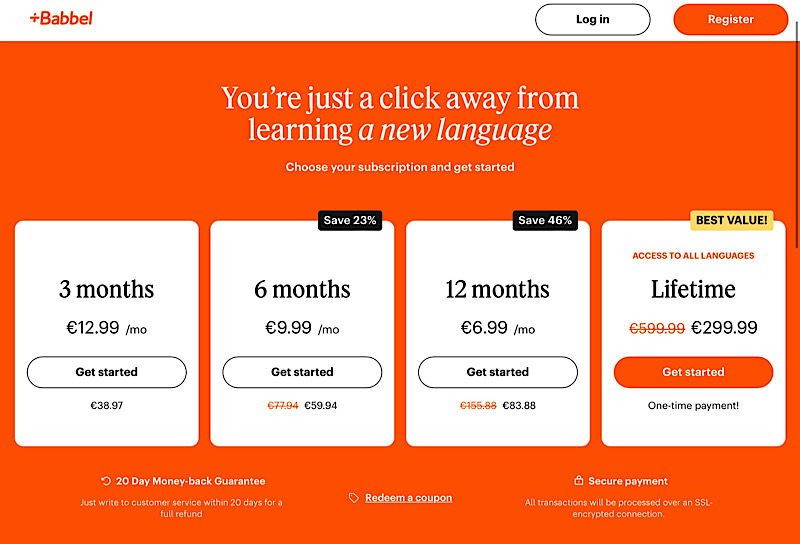
Subscriptions start at 3 months, with the option for 6 or 12. The longer your plan, the lower the monthly rate: 3 months cost €12.99/month, a year dips down to €6.99. That’s a decent discount if you plan to stay for the full year, though it’s a step up from previous price points.
Babbel’s once-absent lifetime offer has returned, too, granting you access to all 13 languages forever. That includes the entire course library and cross-platform functionality. It’s a great deal if you’re interested in learning multiple languages.
We’ve seen some wild price swings on lifetime plans, anywhere from €349 all the way down to €179. The button below goes to their offer page, so you can see the current price:
Babbel also offers a 20-day money-back guarantee. You can contact customer service for a full refund within that time.
But WATCH OUT if you’re buying in-app! Their mobile store prices are usually higher—Babbel passes on some or all of the 30% app store fees to the user. So buy via the website. You can still log in to the app with your website credentials afterwards, saving you a decent chunk of money.
talkREAL Tip! Check out our Babbel costs article for a detailed breakdown of subscription options, “Babbel for Two,” and payment methods. If you do sign up and eventually want out, you might need our guide on Babbel cancellations.
Is the Price Worth It?
The best way to answer that is by checking the competition. Instead of scouring the web for each service, take a look at our language-course price comparison, where you’ll find the best-known courses side by side. We’ll share some tips on getting the most value for your money.
Speaking of saving: language learning doesn’t have to be expensive. Here’s where to find the best coupons and discounts, letting you start your language journey cheaply. Check it out quick! Besides the many Babbel alternatives you’ll see shortly, there are other providers with innovative ideas. Definitely worth a look!
Alternatives: Babbel Experiences Compared with Competitors
Babbel is definitely a course many people will enjoy. Still, it’s sometimes good to look beyond. We see three solid Babbel alternatives:
Mondly – The Motivator
Mondly is the up-and-comer among language-learning apps. It’s not that well-known yet, but it’s technically flawless, and with strong gamification elements, it keeps you motivated. No wonder Mondly earned the top rank in our “Motivation” category. It mixes plenty of interesting features in a single app.
Its 4.8 out of 5 rating on the Google Play Store also speaks volumes. We’d recommend Mondly to anyone who struggles with motivation. Babbel’s motivational side used to be better but has slipped recently, whereas Mondly picks up that slack. Plus, you get lifetime access to all 41 languages for around the same price Babbel charges for one year of a single language.
Mosalingua – Powerful Vocab Trainer with AI Integration
Mosalingua recently snatched the “Rising Star” spot in our tests. The Mosalingua review shows how they’ve improved so dramatically, they’re now a favorite among our editors. Especially their use of artificial intelligence is brilliant—no other app integrates AI so effectively to enhance its language courses.
But it’s not just the learning concept that’s gotten better; Mosalingua also offers excellent bang for your buck, plus a 2-week free trial. It’s definitely worth creating a profile at Mosalingua and testing the app—no commitment needed.
Langotalk – The Newcomer That Stunned Us
If you want a completely different method, Langotalk might be for you. It’s an intelligent, AI-based language tutor that not only lets you practice what you‘ve learned in creative conversation prompts, it also teaches you new input based on your personal preferences. We were super impressed!
And yes, they have a fair lifetime offer, letting you grab all 20+ languages and courses forever, often for only a little over $100. With a free trial, there’s nothing to lose.
talkREAL Tip! For even more info, our Babbel Guide includes direct comparisons of Babbel vs. other language courses like Duolingo and more. Check it out now!
Final Verdict: Babbel Review 2025
‒ Babbel’s Moving Up Again with Great New Features ‒
Even after our thorough 2025 review, we’re still happy to “babble” along. The online language-course provider has a lot going for it, and Babbel is simply fun to use. They do what they do well. Despite having dropped some excellent features in recent years, they’re replacing them with new ones—and so we’ve concluded it’s still good, especially for beginners!
Its core remains quite traditional, but Babbel still outdoes typical classroom learning—especially with the new AI-based features that truly set it apart from old-school competition. The short, snappy lessons are backed by scientific insights, particularly in spaced repetition, and you’re listening to native speakers instead of a monotone computer voice.
In our previous review, it felt like apps like Mondly had overtaken Babbel in recent years, but now we can definitely say Babbel’s back on track! They keep introducing well-developed new features, and course content is slowly but surely getting deeper.
Their pricing has changed as well. While some subscription options have gone up, it’s still a fair cost overall. The once-occasional lifetime offer is now permanent—and that’s a great deal!
Didactics:
8.5 / 10
Usability:
8.5 / 10
Value for Money:
8.5 / 10
Overall Rating: 8.5 / 10
